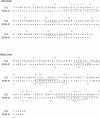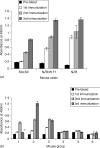Autoreactive responses to an environmental factor: 1. phthalate induces antibodies exhibiting anti-DNA specificity
- PMID: 14632646
- PMCID: PMC1783077
- DOI: 10.1111/j.1365-2567.2003.01765.x
Autoreactive responses to an environmental factor: 1. phthalate induces antibodies exhibiting anti-DNA specificity
Abstract
Environmental factors have been implicated in the induction of autoimmune disorders. We report here that a common chemical, phthalate, used widely in synthetic polymers and cosmetics induces serum anti-self DNA antibodies in BALB/c, NZB and autoimmune-prone NZB/W F1 mice. The latter group experiences a high mortality, and significantly higher anti-DNA antibody levels along with nephritis and other histopathologic changes in kidney. Comparison of amino acid sequences of an anti-phthalate BALB/c B-cell hybrid, 2C3 with the known database at the National Center for Biotechnology Information reveals a striking homology between the variable regions of 2C3-Ig (gamma1, kappa) and an anti-DNA antibody, BV04-01 (gamma2b,kappa) isolated from the lupus-prone NZB/W F1 mice. The homology is 98% for kappa light chain and 70% for gamma heavy chain. Like 2C3-Ig, BV04-01 also has specificity for d(pT)4. Furthermore, the light chains of both 2C3-Ig and BV04-01 are products of Vkappa1 gene. To understand the nature of anti-phthalate responses in general, hybridomas generated from phthalate-keyhole limpet haemocyanin-primed BALB/c splenocytes were characterized. The study identifies cross-reactive populations that strongly bind phthalate, DNA, or both. Of the 14 hybridomas evaluated, six express the same Vkappa1 gene-derived light chain as 2C3, and bind both phthalate and ds and ss-DNA. They specifically recognize the oligonucleotides, d(pT)4, and d(pT)10. Additionally, when antisera raised against idiopeptides corresponding to 2C3-Ig hypervariable regions are allowed to react with 2C3-Ig, their binding is blocked specifically by both d(pT)4 and phthalate. This study clearly demonstrates that phthalate exposure leads to activation of a significant number of autoreactive B-cells, with the consequence of a significant pathogenic progression in susceptible NZB/W F1 mice but not in non-autoimmune-prone BALB/c.
Figures









References
-
- Pearson L, Lightfoot RJ. Correlation of DNA–anti DNA association rates which clinical activity in systemic lupus erythematosus SLE. J Immunol. 1981;126:16–9. - PubMed
-
- Tan EM. Antinuclear antibodies: diagnostic markers for autoimmune disease and probes for cell biology. Adv Immunol. 1989;44:93–151. - PubMed
-
- Marion TN, Tillman DM, Jou NT, Hill RJ. Selection of immunoglobulin variable regions in autoimmunity to DNA. Immunol Rev. 1992;128:123–49. - PubMed
-
- Diamond B, Katz JB, Paul E, Aranow C, Lustgarten D, Scharff MD. The role of somatic mutation in the pathogenic anti-DNA response. Annu Rev Immunol. 1992;10:731–57. - PubMed
Publication types
MeSH terms
Substances
Grants and funding
LinkOut - more resources
Full Text Sources

